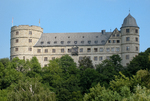Schloß Wewelsburg
| Type | 27 Other | |
| Historical Name of Location | Büren, Westfalen, Germany | |
| Coordinates | 51.606389000, 8.651667000 |
Contributor: C. Peter Chen
ww2dbaseThe Wewelsburg Castle (German: Schloß Wewelsburg) in central Germany was, in its current form, completed in 1609. It was seriously damaged in the subsequent 300 years, by both wars and natural disasters, and after a fire caused by lightning in 1832, the castle remained in poor shape for the next 100 years. In 1924, the castle became the property of the town of Büren, which set forth a plan to transform the structure into a museum, banquet hall, and cultural center, but the renovations generally ceased in the next few years.
ww2dbaseIn Nov 1933, Heinrich Himmler, accompanied by Karl Maria Wiligut and others, inspected the castle. Both of them believed in the occult surrounding a mystic ancient Nordic-German master race, and the castle's location, which was near both the Externsteine rock formation and the site of the prophesized Battle at the Birch Tree, drew them. Through Himmler's influence, the SS organization leased the castle from BĂĽren for 100 years at the cost of 1 Reichsmark per year. In 1934 alone, Himmler would spend 11 million Reichsmarks in renovating it into a sort of a "SS Black Camelot"; through 1943, he would spend another 4 million Reichsmarks. Between 1939 and 1943, the Niederhagen Concentration Camp existed nearby to supply forced laborers for Wewelsburg construction projects. The camp held over 1,000 forced laborers at its height, most of whom were Jehovah's Witnesses and Soviet prisoners of war.
ww2dbaseThe castle had an unusual triangular footprint due to the shape of the hill it resided atop of, resulting in a dramatic north tower that Himmler liked. Over the next few years, the north tower would become the focal point of the castle, containing a room for pagan rituals. As the castle was also dedicated for the study of ancient Germanic lore, the castle contained several research rooms, many of which named after figures Himmler deemed worthy of SS idolatry (eg. König Heinrich (King Heinrich I), Heinrich der Löwe (Henry the Lion), and König Artus (King Arthur)) or named after mystic themes (eg. Gral (the Holy Grail), Arier (Aryan), and Deutscher Orden (Teutonic Order)). A crypt was constructed containing niches for the ashes of deceased SS men. Some of the weddings of important SS figures took place at this castle, sometimes with Himmler or Wiligut presiding over the ceremonies. The Death's Head rings worn by SS men made their ways to the castle after their owners' deaths; this represented a spiritual continuity of the wearers and the SS order.
ww2dbaseIn 1936, Himmler founded the Association for the Advancement and Maintenance of German Cultural Relics, a front to collect funding for the upkeeping of the castle.
ww2dbaseElaborate plans to expand the castle existed, making it the center of a very large SS complex, which in term was to become a sort of a spiritual center of Nazi Germany. Following Himmler's belief in the occult, prominent features of the complex was to form the shape of a spear, said to present the Spear of Destiny of Christian mythology, with Schloß Wewelsburg forming the spearhead, with the castle's north tower as the tip.
ww2dbaseIn Mar 1945, as US 3rd Armored Division approached, Commandant Siegfried Taubert abandoned his post. On Himmler's orders, SS men attempted to demolish the castle, but the damage they caused was minimal. Structurally, only the southeastern tower was damaged, while the fires they set throughout the castle only caused superficial harm.
ww2dbaseStarting in 1950, Schloß Wewelsburg operated as a museum and a youth hostel.
ww2dbaseSources:
Bill Yenne, Hitler's Master of the Dark Arts
Wikipedia
Last Major Update: Sep 2013
Schloß Wewelsburg Interactive Map
Photographs
 |
Schloß Wewelsburg Timeline
| 3 Nov 1933 | Heinrich Himmler, Karl Maria Wiligut, and other SS figures visited Schloß Wewelsburg in Büren, Germany. |
| 22 Sep 1934 | The first stage of renovations at the SS castle of Schloß Wewelsburg in Büren, Germany was completed, and a ceremony was held to mark the transfer of its possession to Heinrich Himmler. |
| 12 Jun 1941 | A three-day conference of SS men of SS-Gruppenführer rank began at the SS castle of Schloß Wewelsburg in Büren, Germany. |
| 30 Mar 1945 | Commandant of the SS castle of Schloß Wewelsburg in Büren, Germany, Siegfried Taubert, abandoned the castle as US 3rd Armored Division approached. |
| 31 Mar 1945 | On Heinrich Himmler's orders, men led by SS-Sturmbannführer Heinz Macher attempted to use tank mines to demolish the SS castle of Schloß Wewelsburg in Büren, Germany. The attempt only damaged the southeast tower, while the rest of the castle, was damaged by fires. The 9,000 SS Ehrenring (SS Honor Rings) stored at the castle were taken away by Macher and were buried at a secret location in nearby woods. |
| 29 Jun 1950 | Schloß Wewelsburg in Büren, Germany began operating as a museum and a youth hostel. |
Did you enjoy this article or find this article helpful? If so, please consider supporting us on Patreon. Even $1 per month will go a long way! Thank you. Share this article with your friends: Stay updated with WW2DB: |
| WW2-Era Place Name | Büren, Westfalen, Germany |
| Lat/Long | 51.6064, 8.6517 |
- » 1,150 biographies
- » 337 events
- » 44,024 timeline entries
- » 1,242 ships
- » 350 aircraft models
- » 207 vehicle models
- » 375 weapon models
- » 123 historical documents
- » 260 facilities
- » 470 book reviews
- » 28,587 photos
- » 432 maps
James Forrestal, Secretary of the Navy, 23 Feb 1945
Please consider supporting us on Patreon. Even $1 a month will go a long way. Thank you!
Or, please support us by purchasing some WW2DB merchandise at TeeSpring, Thank you!